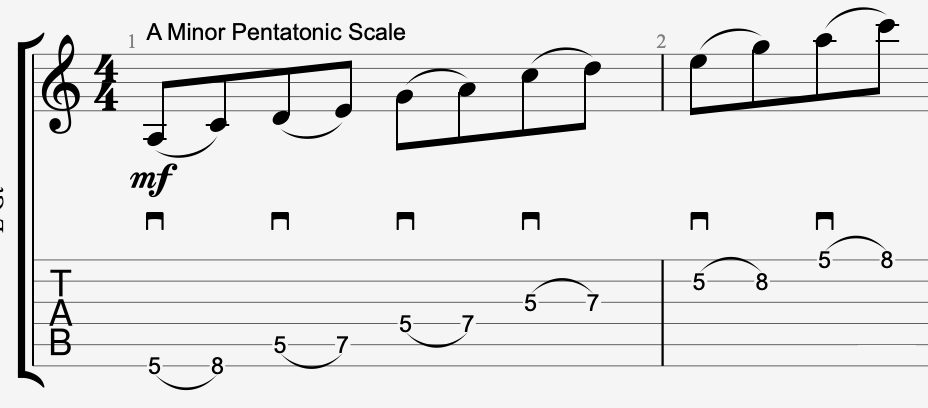In today’s guitar lesson I’m going to cover five simple ways to improve your pentatonic scales and make your soloing more interesting. This is a lesson that I’ve been doing with many of my students getting into rock and blues improvisation.
Online guitar lessons with Craig Winston

If you’ve followed me for a while, you know that I’m all about small, consistent steps towards a larger goal. We have to understand that over time our efforts will compound and soon enough we’ll start to see great results.
The overall theme of the lesson is to set constraints, so with that in mind you can apply the same approach to many other guitar skills and technique. The secondary theme is to improvise in order to apply these concepts.
Five simple ways to improve your pentatonic scales
Here is my short list of Five simple ways to improve your pentatonic scales:
Hammer-ons
Pull-offs
Chromatic Approaches
Bends
Slides
For many of you reading this, you might think that this list is too simple, that it contains some rather remedial techniques. However, I’d argue that many of these techniques are so essential to our conception of the sound of the guitar that you should be working diligently on improving each one as much as possible.
Why these five techniques?
In my experience, we can achieve not only more speed through implementing many of these left hand techniques, but more importantly we gain an array of articulations. With the exception of Chromatic Approaches, all of the above items I listed are a means to either mask the articulation of the second note in a line or to change the accent pattern of a line. For example a hammer-on involves a pick attack on the first note and the second note will sound softer as it lacks that same attack.
Similarly, sliding or bending to a note will get rid of an attack on the second note altogether.
Five ways to practice the pentatonic scale
For today’s guitar lesson we’re only going to work on the A Minor Pentatonic. Go ahead and play through the scale by picking every note:

Since we have two notes per string when using this shape, we can easily play it ascending with hammer-ons:

Similarly, on the way down we can play using pull-offs:

Notice the difference already between the two sounds. Pull-offs definitely have a bit more articulation on the second note than the hammer.
Now, look up a backing track on your favorite music listening app, or search youtube for A Minor backing track. Your goal is to play through 2 minutes with one single constraint: every time you play an ascending note on the same string, you must use a hammer-on.
Then play two more minutes where the opposite is true: for all descending notes on the same string you must use a pull-off.
The point is really to try to play as much with each technique as possible without playing two picked articulations on the same string. Hopefully you will overemphasize the use of pull-offs or hammer-ons during those two minutes.
Chromatic Approaches
The following item can be saved for last if you like, because it can be performed using all of the other techniques discussed. But the basic idea is to approach each note of the scale from one fret below (when ascending) and one fret above (when descending). These approaches should be played as gracenotes:

Again, go to your backing track, and for the next two minutes go nuts with the chromatic approaches.
These chromatic grace notes will serve to really offset the rhythm of whatever passage you play by essentially placing the accent about a 32nd note after the beat.
Bends
The next technique is to bend the second note on each string leading to the note on the next upper string:

Descending you could try pre-bending the fifth fret to the note on the upper fret on each string and then releasing to the lower note, but it’s ok to keep it simple for now.
Notice the total absence of articulation when you use a bend in your improvisation. This is one of the magic qualities of the guitar, allowing it to sound more vocal in nature than many other instruments.
Playing the pentatonic scale with slides
Lastly, we want to practice sliding between notes. This is very much like we did with the hammer-ons and pull-offs, only now we slide depending on which direction we are going. Ascending? Or Descending?

Improvise with this idea for a bit and you’ll hear something of a special effect if you play the slide as a gracenote. Slides don’t mask the beat as much as a bend, but can still be a great variation from the normally picked accent pattern.
Applying these techniques
These are five simple ways to improve your pentatonic scales. We approached each concept with a constraint that we had to narrow our focus during improvisation to that one idea. I hope you practice through this lesson a few times and that it inspires you to start thinking of creative ways you can challenge yourself.
Ever improvise a solo with just one finger? On a single string? 4 notes per string? All finger tapping? Without using the right hand?
Happy practicing!
Craig
